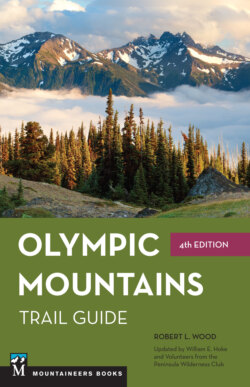Читать книгу Olympic Mountains Trail Guide - Robert Wood - Страница 36
На сайте Литреса книга снята с продажи.
1SPRUCE RAILROAD TRAIL
ОглавлениеLength: 4.1 mi/6.5 km
Access: Camp David Jr. Road; East Beach Road
Custom Correct Map: Lake Crescent / Happy Lake Ridge, Washington
Green Trails Map: Lake Crescent, Wa. No. 101
Agency: Olympic National Park
This is a good trail to hike during the winter. It is unique in the Olympics because it follows an old railroad grade, that of the Spruce Railroad, about 600 feet above sea level, along the north shore of Lake Crescent. During World War I, the government built the railroad from Port Angeles to the west side of the Olympic Peninsula in order to obtain spruce to use in airplane construction.
The trail has been incorporated into the larger Olympic Discovery Trail, a non-motorized trail system that stretches across the Olympic Peninsula from Port Townsend to the Pacific coast. This is one of the few trails in the Olympic National Park that is open to bicycles and pets.
Snow often covers the peaks and ridges above the trail in the winter. On cloudy days Lake Crescent is slate-colored, but the views are excellent, and the friendly ducks—hungry now that the tourists have departed—will approach you and engage in a bit of panhandling. (However, the park strongly discourages the feeding of any wild animals.) During the summer, ticks are abundant and can be a problem. So too, the poison oak. In fact, this is one of the few places in the Olympics where both ticks and poison oak are encountered.
The trail starts just off the East Beach Road near the lake’s outlet and climbs away from the water, going by the remnants of an old orchard. The first mile of the trail has been turned into a gravel road to provide access to the McPhee Tunnel. The trail then descends back to the lake and keeps close to the shore, where it provides frequent views of the lake and the forested peaks, including Mount Storm King. On the trail’s uphill side the slopes are clad with dark, somber conifers. After rounding Harrigan Point, the trail turns southeast as it approaches McPhee Tunnel. At the tunnel’s west entrance (1.1 mi/1.8 km) the trail splits; to the right it enters the tunnel, recently reopened by the park. The basalt rock has been stabilized by covering the surface with sprayed concrete. Hikers choosing this route should take a flashlight since the tunnel is quite dark.
The trail to the left climbs slightly to round Devils Point (1.1 mi/1.8 km), which has splendid views up, down, and across the lake, and is deeply indented by a little bay or cove called Devils Punch Bowl. This is the most picturesque spot on the route. The cliffs of pillow basalt come down precipitously to the water, and the lake is deep near the shore. The trail crosses the cove via a steel and wood bridge that arches over the water to the next jutting headland. The rock walls bordering the bay are decorated with mosses, ferns, and stonecrop.
Beyond the bridge, the trail skirts basalt cliffs at the lake’s edge, then rejoins the railroad grade at the tunnel’s south entrance and returns to the railroad grade. A little creek (1.5 mi/2.4 km) that cascades down the slopes of Pyramid Mountain is the only stream of consequence on the trail. At various places the path goes by basalt cliffs 150 to 200 feet high, where madrona trees cling to the barren rocks. All along this section the trail has numerous “windows” among the trees. The views they provide across the lake are better during the winter and spring, before the leaves develop on the deciduous trees.
The trail continues to follow the easy railroad grade as it approaches the Daley Rankin Tunnel (2.7 mi/4.5 km). One can see through the tunnel but the floor is blocked by large timbers and rocks. The tunnel was scheduled to be cleared and reenforced like the McPhee Tunnel in the summer of 2019 and open for foot and bicycle use. At any rate, the hiker should not miss the view from the trail around this point, which is directly opposite the delta of Barnes Creek. Here the lake is narrow—not more than a half mile wide—and one can see Lake Crescent Lodge and the cabins on the far shore. The path to the west of the tunnel has been widened to accommodate the expansion of the Discovery Bicycle Trail.
Beyond the second tunnel the trail once again follows the railroad grade, going through a mixture of second-growth and virgin timber, mostly stands of Douglas-fir, where more windows are present. The trail then leaves the railroad grade and descends to the end of the Camp David Jr. Road (4.1 mi/6.5 km).
